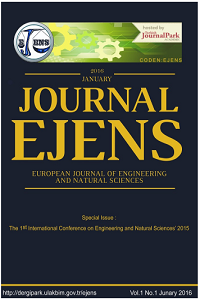Determination of Turbidity in Filyos Stream Water by Artificial Neural Network
Determination of Turbidity in Filyos Stream Water by Artificial Neural Network
Filyos Stream, Heavy Metal, Turbidity, Artificial Neural Networks,
___
- [1]. APHA Standart Methods for the Examination of Water and Waste Water, 20th Ed., APHA, AWWA, WEF, Washington , D. C., 1998.
- [2]. Ay M, Su Kalitesi Parametrelerinin Yapay Zeka Yöntemleri İle Değerlendirilmesi, Doktora Tezi, Erciyes Üniversitesi, Fen Bilimleri Enstitüsü, İnşaat Mühendisliği Anabilim Dalı, Kayseri, 117, 2014.
- [3]. Bayram A, Harşit Çayı Su Kalitesinin Mevsimsel Değişiminin İncelenmesi Ve Askı Madde Konsantrasyonunun Yapay Sinir Ağları Yöntemi İle Tahmin Edilmesi, Doktora, Karadeniz Teknik Üniversitesi, Fen Bilimleri Enstitüsü, İnşaat Mühendisliği Anabilim Dalı, Trabzon, 163, 2011.
- [4]. Bayram A ve Kenanoğlu M, Temporal Variation of Total Nitrogen and Total Phosphorus in Surface Waters from the Lower Çoruh River Basin, Turkey, 3rd International Conference on Computational and Experimental Science and Engineering, 19-24 Ekim 2016, Antalya, Türkiye, 132(3): 712-716, 2017.
- [5]. Doğan E, Şengörür B ve Köklü R, Modeling Biological Oxygen Demand of the Melen River in Turkey Using An Artificial Neural Network Technique, Journal of Environmental Management, 90, (2): 1229-1235, 2009.
- [6]. İçağa Y, Bostanoğlu Y ve Kahraman E, Akarçay Havzası Su Kalitesi İstatistikleri. Yapı Teknolojileri Elektronik Dergisi, 2(1): 43-50, 2006.
- [7]. Kajiya T, Schellenberger F, Papadopulos P, Vollmer D and Butt H J, 3D Imaging of Water-Drop Condensation on Hydrophobic and Hydrophilic Lubricant-Impregnated Surfaces. Nature, 6: 1-10, 2016.
- [8]. Minarecioğlu N, Doğal Akarsularda Taşınan Katı Madde Miktarının Yapay Zeka Yöntemleri Kullanılarak Tahmin Edilmesi, Yüksek Lisans, Erciyes Üniversitesi, Fen Bilimleri, İnşaat Mühendisliği Anabilim Dalı, Kayseri, 68, 2008.
- [9]. Öztemel E, Yapay Sinir Ağları, 3. Baskı, ISBN: 9756797396, Papatya Bilim, İstanbul, 232,2016.
- [10]. Sönmez A Y, Hisar O ve Yanık T, Karasu Irmağında Ağır Metal Kirliliğinin Tespiti ve Su Kalitesine Göre Sınıflandırılması. Atatürk Üniversitesi Ziraat Fakültesi Dergisi, 43(1): 69-77, 2012.
- Başlangıç: 2015
- Yayıncı: CNR Çevre
Koray KARABULUT, Dogan Engin ALNAK, Ferhat KOCA
The Abrasion Resistance of Mortars Containing Natural Zeolite Analcime
An Alternative Method for Long-Term Land Cover Change Detection: A Case Study of Hasanlar Dam
Firat Caglar Yilmaz, Sukran Sahin
Wastewater Treatment by Floating Macrophytes (Salvinia Natans) Under Algerian Semi-Arid Climate
Laabassi AYACHE, Boudehane ASMA
Development of Ecological Biodesign Products by Bacterial Biocalcification
Tuğba Keskin Gündoğdu, İrem DENİZ, Alpcan ARİC, Burak Talha YILMAZSOY, Ozge ANDİC CAKİR, Aysegul ERDOGAN, Didem ALTUN, Ayca TOKUC, Burcu Filiz DEMİRCİ, Aylin SENDEMİR, Gulden KOKTURK, Feyzal Ozkaban
Kinetics of Granulated Waste Tyre Pyrolysis via Thermogravimetry and Model-Free Methods
Peter T. CHEROP, Sammy L. KİAMBİ, Paul MUSONGE
Determination of The Hip Stem Loosening Using Vibration Method
An Image-based Recommender System Based on Image Annotation
Kemal ÖZKAN, Zühal KURT, Erol SEKE
Generation of a Multi-Layered Diffusion Coating on an Interstitial-Free Steel
